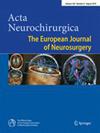Combined exoscopic and endoscopic oblique approach to parafalx lesions while preserving normal structures via the interhemispheric fissure: How I do it
IF 1.9
3区 医学
Q3 CLINICAL NEUROLOGY
引用次数: 0
Abstract
Background
When treating parafalx lesions, the bridging veins or the frontal sinuses can sometimes obstruct access. Preserving these structures to avoid surgical complications is preferred.
Methods
We described the concept of the selective interhemispheric oblique approach (SIOA), which combines exoscopic and endoscopic visualization with gravity-assisted brain retraction to ensure safe access to the parafalx lesions.
Conclusions
The SIOA is a precise and versatile technique for treating parafalx lesions, particularly in anatomically complex areas. With this approach, it’s possible to mitigate risk of venous injury or sinus opening, avoid the retraction of eloquent areas, and obtain excellent surgical outcomes.
经半球间裂保留正常结构的外窥镜和内窥镜斜入路联合治疗腹旁病变:我是如何做到的
背景在治疗大脑镰旁病变时,桥静脉或额窦有时会阻塞手术通道。方法我们描述了选择性大脑半球间斜切入路(SIOA)的概念,它将外镜和内镜可视化与重力辅助脑牵引相结合,以确保安全进入大脑镰旁病变。结论SIOA是治疗大脑镰旁病变的一种精确而多用途的技术,尤其适用于解剖结构复杂的区域。通过这种方法,可以降低静脉损伤或窦开放的风险,避免牵拉脑区,并获得极佳的手术效果。
本文章由计算机程序翻译,如有差异,请以英文原文为准。
求助全文
约1分钟内获得全文
求助全文
来源期刊

Acta Neurochirurgica
医学-临床神经学
CiteScore
4.40
自引率
4.20%
发文量
342
审稿时长
1 months
期刊介绍:
The journal "Acta Neurochirurgica" publishes only original papers useful both to research and clinical work. Papers should deal with clinical neurosurgery - diagnosis and diagnostic techniques, operative surgery and results, postoperative treatment - or with research work in neuroscience if the underlying questions or the results are of neurosurgical interest. Reports on congresses are given in brief accounts. As official organ of the European Association of Neurosurgical Societies the journal publishes all announcements of the E.A.N.S. and reports on the activities of its member societies. Only contributions written in English will be accepted.
 求助内容:
求助内容: 应助结果提醒方式:
应助结果提醒方式:


